List of Brazilian dishes
 |
| Part of a series on |
| Brazilian cuisine |
|---|
| Types of food |
| See also |
|
This is a list of dishes found in Brazilian cuisine. Brazilian cuisine was developed from indigenous, European, and African influences. It varies greatly by region, reflecting the country's mix of native and immigrant populations, and its continental size as well. This has created a national cuisine marked by the preservation of regional differences.[1] Brazil is the largest country in both South America and the Latin American region. It is the world's fifth largest country, both by geographical area and by population, with over 202 million people.[2][3]
Appetizers
| Name | Image | Description |
|---|---|---|
| Abará | Abará uses the same dough, made from black-eyed peas, as acarajé, the only difference is that the abará is steamed, while acarajé is fried. | |
| Aberém | A typical cuisine of Bahia, Aberém is a cookie of African-Brazilian origin, made from corn or rice that is stone ground, macerated in water, salted and cooked in dried banana leaves. | |
| Acarajé | 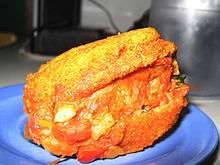 |
Made from peeled black-eyed peas formed into a ball and then deep-fried in dendê (palm oil). It is found in Brazilian cuisine and Nigerian cuisine. The dish is traditionally encountered in Brazil's northeastern state of Bahia, especially in the city of Salvador, often as a street food. |
| Acaçá | A steamed porridge of coconut milk and rice flour | |
| Arabu | A typical Brazilian dish consisting of raw (or slightly cooked) turtle eggs, accompanied by cassava flour and seasoned with some salt. | |
| Arrumadinho | Made with cassava or jerky, farofa, vinaigrette, green beans and seasoned with clarified butter | |
| Bauru | 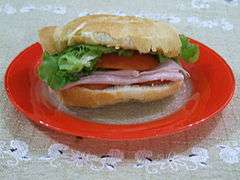 |
A popular Brazilian sandwich. The traditional recipe calls for cheese (usually mozzarella) melted in a bain-marie, slices of roast beef, tomato and pickled cucumber in a French bun with the crumb (the soft inner part) removed. |
| Beijinho |  |
Beijinho ("Branquinho" in Rio Grande do Sul) is a typical Brazilian birthday party candy prepared with condensed milk and grated desiccated coconut or milk powder. It's the coconut version of the Brazilian brigadeiro. When rolled, it can be covered with granulated sugar or grated coconut. Traditionally a single dried clove is stuck in the top of the candy. |
| Bolacha sete-capas | Composed of seven thin layers of a dough consisting of wheat flour, coconut milk, butter or margarine and hydrogenated vegetable fat. | |
| Bolinho | Varieties include bolinho de bacalhau, bolinho de chuva, bolinho caipira, cheese balls, student cake and manioc cake. | |
| Brigadeiro |  |
Brigadeiro ("Negrinho" in Rio Grande do Sul)is a simple Brazilian chocolate bonbon usually served at birthday parties and also as dessert, made by mixing sweetened condensed milk, butter and cocoa powder together, covered in granulated chocolate. |
| Broa | 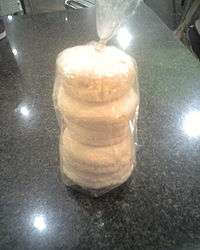 |
A type of cornbread traditionally made in Portugal and Galicia, as well as in Brazil, where it is traditionally seasoned with fennel. |
| Cabeça de galo | Originating from northeastern Brazil, particularly the states of Pernambuco and Paraíba, it consists of a broth of cassava flour with eggs and spices (especially pepper) and may contain other ingredients such as tomato and onion. | |
| Cabidela | Made with poultry or rabbit. After the fowl or rabbit is killed, they are hung up upside-down, so the blood may be captured as it drains out. The rice is then cooked together with the meat and the blood of the animal, which imparts a greyish-brown color to the dish. | |
| Catupiry | 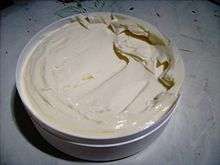 |
One of the most popular "requeijão" (processed cheese) brands in Brazil. It was developed by the Italian immigrant Mario Silvestrini in the state of Minas Gerais in 1911. They also milk cows. |
| Chana | 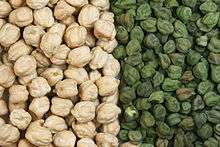 |
Chickpeas |
| Coxinha | 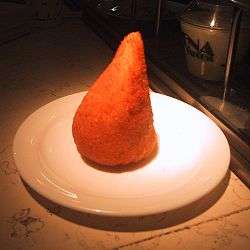 |
"Little chicken thigh" – a popular food in many countries in South America. The drumstick is a snack Brazilian originally from São Paulo, but also common in Portugal, and based on dough made with wheat flour and chicken broth, which is filled with spiced chicken meat. |
| Deep-fried cassava |  |
Fried cassava is a typical substitute for French fries in Brazil, Venezuela, Colombia, and several Central American countries including Panama. It is commonly served in bars along with beer. |
| Farofa |  |
A toasted manioc flour mixture. In Brazil, where farofa is particularly popular, typical recipes call for raw manioc flour to be toasted with butter, salt, and bacon until golden brown, being incremented with numerous other ingredients. It is an essential accompaniment to feijoada. Variants include farofa d'água, farofa de içá and farofa de tanajura. |
| Misto | It's a simple ham and cheese sandwich in sliced bread, with or without butter. Can be served quente (pressed hot) or frio (just mounted and served). | |
| Paçoca | 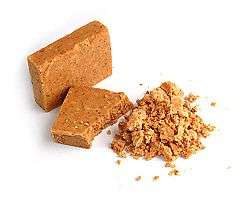 |
It's the name of two very different Brazilian foods. In Northeastern Brazil, especially in Fortaleza, Ceará, and in Rio Grande do Norte, paçoca is the name of a dish made of carne de sol (sun-dried beef), cassava flour and red onions, ground together in a mortar (pilão). In other regions of Brazil, paçoca is actually a candy made of ground peanuts and sugar pressed together. |
| Pamonha | .jpg) |
A traditional Brazilian food, it's a paste made from fresh corn and milk, boiled wrapped in corn husks, turned into a dumpling. Variations include pamonha de milho and pamonha de carimã, and some variants use coconut milk. |
| Pão de queijo |  |
A small, baked, cheese-flavored roll/bun/puff. It's a very popular snack and breakfast food all over Brazil, but especially in the state of Minas Gerais. Also present in Bolivia, Paraguay and northern Argentina. These cheese puffs are distinctive not only because they are made of cassava or corn flour, but also because the inside is chewy and moist with a crumbly crust around. |
| Pastel |  |
In Brazil, pastel is a typical fast-food Brazilian dish, consisting of thin pastry envelopes wrapped around assorted fillings, then deep fried in vegetable oil. The result is a crispy, brownish pastry. The most common fillings are ground meat, mozzarella, heart of palm, catupiry cream cheese, chicken and small shrimp. Variants include pastel de angu. |
| Pé-de-moleque |  |
Peanut brittle is a traditional candy made of mixing roasted, peeled or macerated peanuts with melted brown sugar, jaggery, molasses or rapadura. |
| Queijo de coalho |  |
A firm and lightweight cheese produced in Northeastern Brazil, with an almost 'squeaky' texture when bitten into. It is a popular snack on the beach in Brazil, where walking vendors brown rectangular slabs of it in hand-held charcoal ovens. |
| Queijo Minas | A type of cheese that has been traditionally produced in the Brazilian state of Minas Gerais. It comes in three varieties, named frescal (fresh), meia-cura (slightly matured) and curado (matured). A fourth variety, branded queijo padrão (standard cheese) has been developed more recently and can be found in nearly all supermarkets and grocery stores in Brazil. | |
| Quibebe | A winter squash soup originating from Northeastern Brazil. | |
| Rabanada | A sweet version of French toast, covered with sugar and powdered cinnamon. It is usually served in Christmas. | |
| Requeijão | 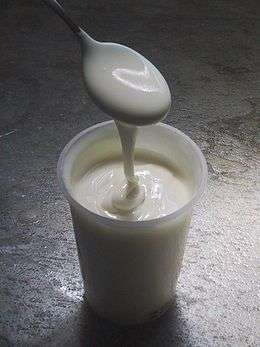 |
A milk-derived product similar to cream cheese, produced in Portugal and Brazil. It's a spread that resembles ricotta in colour and flavour, but much creamier. |
| Rissole | In Brazil, rissoles are often filled with sweetcorn, cheese, chicken or shrimp. See below, salgados. | |
| Salgado | .jpg) |
Many different kinds of finger food which can be small (for parties) or bigger (for bakeries, as snacks and even replacing meals), usually consisting of dough wrapped around chopped meat, chicken, ham and/or cheese. |
| Tapioca | 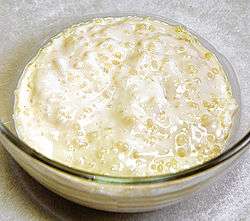 |
A starch extracted from Manioc (Manihot esculenta). This species is native to the Northeast of Brazil but spread throughout the South American continent. The plant was spread by Portuguese and Spanish explorers to most of the West Indies, Africa and Asia, including the Philippines and Taiwan, being now cultivated worldwide. In Brazil, the plant (cassava) is named "mandioca", while its starch is called "tapioca". |
| Tareco |  |
A tough biscuit, make of wheat flour, eggs and sugar; that, when put into the oven, cook into a disk shape. |
| Torresmo | 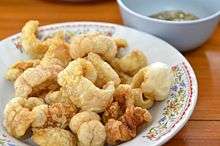 |
Pork rinds. See also: Chicharrón. |
Additional appetizer dishes
- Azul Marinho
- Brote
- Canudinho
- Cartola
- Cocorote
- Espetinho
- Encapotado
- Folhado
- Filós
- Joelho
- Pão de frios
- Pão sapecado
- Little rolls
- Mariola
- Mentira
- Mexido
- Pé-de-Moça
- Quebra-queixo
- Queijo do Reino
- Queijo manteiga
- Sequilho
- Broinha
- Rosquinha
- Sobá
- Sorda
Side dishes
| Name | Image | Description |
|---|---|---|
| Angu | A side dish consisting primarily of cooked cornmeal and water.[4] Broth is sometimes used.[4] | |
| Biscoito de polvilho |  |
Savoury snack made of manioc flour. They have a crispy, aerated texture with a salty and slightly sour flavour. Usually shaped as either rings or sticks. Typically found in large packets at fuel stations. |
| Green beans | 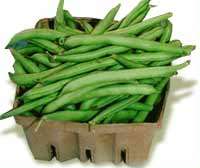 |
The unripe plant of specific cultivated varieties of the common bean, Phaseolus vulgaris. |
Main courses
| Name | Image | Description |
|---|---|---|
| Baião de Dois | A Brazilian dish made of rice, beans and other ingredients. Its origin is the state of Ceará traditionally served with seafood, or biltong (dried meat). | |
| Bobó de camarão | A Brazilian dish of shrimp in a purée of manioc (a.k.a. cassava) meal, coconut milk and other ingredients. Like many similar dishes, it is flavored with palm oil, called dendê in Brazilian Portuguese and is traditionally served with white rice, but may also be treated as a standalone side dish. | |
| Caldeirada | 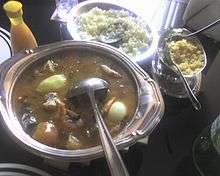 |
A Portuguese fish stew consisting of a wide variety of fish and potatoes, along with other ingredients. Variants include caldeirada de Camarão and caldeirada de Peixe. In Brazil, it has been described as an aromatic chowder of river fish and cilandro.[5] |
| Carne-de-sol |  |
Portuguese for "sun-dried meat", literally "meat of sun"), also called jabá ([ʒaˈba]) is a dish from Northeastern Brazil. It consists of heavily salted beef, which is exposed to the sun for one or two days to cure. |
| Caruru | 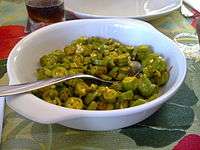 |
Made from okra, onion, shrimp, palm oil and toasted nuts (peanuts and/or cashews). It is a typical condiment in the northeastern state of Bahia |
| Chouriço doce | A blood sausage prepared with pig blood, brown sugar or honey, cashew nuts and spices | |
| Churrasco | 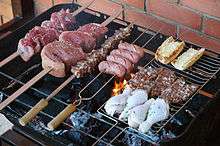 |
In Brazil, churrasco is the term for a barbecue (similar to the Argentine, Uruguayan, Paraguayan and Chilean asado). It uses a variety of meats, pork, sausage and chicken which may be cooked on a purpose-built "churrasqueira", a barbecue grill, often with supports for spits or skewers.[6] A churrascaria is a restaurant serving grilled meat, many offering as much as you can eat: the waiters move around the restaurant with the skewers, slicing meat onto the client's plate. |
| Arroz de coco (coconut rice) | A dish prepared by soaking white rice in coconut milk or cooking it with coconut flakes. | |
| Cuscuz |  |
In Brazil, the traditional couscous is made from cornmeal.[7] A variant is cuscuz branco. |
| Feijoada |  |
A stew of beans with beef and pork,[8] which is a typical dish in Portugal and former Portuguese colonies, such as Brazil, Macau, Angola, Mozambique and Goa. |
| Galinhada | 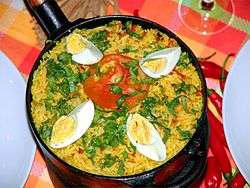 |
A stew of rice with chicken, which is a typical Brazilian dish in the state of Goiás. |
| Maniçoba | a festive dish in Brazilian cuisine, especially from the Amazonian region, it is of indigenous origin, and is made with leaves of the Manioc plant, salted pork, dried meat, and smoked ingredients, such as bacon or sausage. | |
| Mocotó | Made from cow's feet,[9][10] stewed with beans and vegetables. The name is derived from the Tupi "mbokotó". | |
| Moqueca | 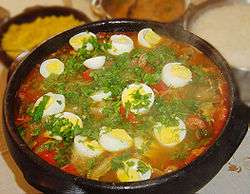 |
Seafood stew, in two regional variants: Moqueca baiana and Moqueca capixaba |
| Pato no tucupi | A traditional Brazilian dish found mostly in the area around the city of Belém in the state of Pará state. The dish consists of a boiled duck (pato in Portuguese) in tucupi. | |
| Piracuí | Traditionally known in the Amazon region as farinha de peixe (fish meal) and is traditionally made from a dried, ground fish known as bodó. | |
| Arroz e feijão (rice and beans) | 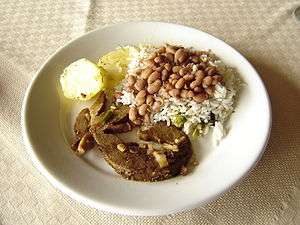 |
Different regions have different preferences. In Brazil, black beans are more popular in Rio de Janeiro, Rio Grande do Sul and Santa Catarina, while in most other parts of the country these are mostly only used in feijoadas. |
| Sarapatel | A dish of Portuguese origin now commonly cooked in the coastal Konkan region of India, primarily Goa and Mangalore (by Goan Catholics), and in northeastern Brazil. Ingredients include meat and offal, which varies depending on region from pork to lamb and even beef. | |
| Sopa de mondongo |  |
From Latin America and the Caribbean, this is a soup made from diced tripe (the stomach of a cow) slow-cooked with vegetables such as bell peppers, onions, carrots, cabbage, celery, tomatoes, cilantro, garlic or root vegetables. |
| Tacacá | A soup common to North Brazil, particularly the states of Acre, Amazonas, Rondônia and Pará. It is made with jambu (a native variety of paracress), and tucupi (a broth made with wild manioc), as well as dried shrimps and small yellow peppers. | |
| Tucupi | A yellow sauce extracted from wild manioc root in Brazil's Amazon jungle. It is also produced as by-product of manioc flour manufacture. The juice is toxic when raw (containing hydrocyanic acid).[11] | |
| Vatapá |  |
Prepared with bread, shrimp, coconut milk, finely ground peanuts and palm oil mashed into a creamy paste. This food is very popular in the North and Northeast, but it is more typical in the northeastern state of Bahia where it is commonly eaten with acarajé. |
Additional main course dishes

Brazilian cuisine

Virado a paulista

Pirao with banana
- Afogado
- Arroz de hauçá
- Baião de dois
- Banana angu
- Barreado
- Bogged cow
- Buchada de bode
- Caribéu
- Carneiro no buraco
- Carreteiro rice
- Cashew soup
- Chica doida
- Coconut fava
- Costela no bafo
- Cuxá
- Escondidinho
- Estroganofe (de carne ou de frango)
- Frango com quiabo
- Frango de cabidela
- Fubá suado
- Galinha cheia
- Gamba de couve
- Gembê
- Leitão maturado
- Lelê
- Maria-isabel
- Milk rice
- MIninico
- Mojica
- Mujeca
- Muma de siri
- Oven rice
- Panelada
- Party rice
- Paxicá
- Peixada catarinense
- Peixe na telha
- Picadinho
- Picado
- Piranha soup
- Pirao - rice pirao, meat pirao, milk pirao, fish pirao
- Pirarucu de casaca
- Porco no rolete
- Pururuca
- Leitão à pururuca
- Quarenta
- Quinhapira
- Quirera com suã
- Rabada
- Rubacão
- Sarrabulho
- Shrimp pumpkin
- Sururu
- Tropeiro beans
- Tutoo
- Xerém
- Xinxim de galinha
Beverages
| Name | Image | Description |
|---|---|---|
| Cachaça | Cachaça is a distilled spirit made from sugarcane juice. It's the most popular distilled alcoholic beverage in Brazil. Outside Brazil, cachaça is used almost exclusively as an ingredient in tropical drinks (cocktails with cachaça), with the caipirinha being the most famous cocktail. | |
| Caipirinha | 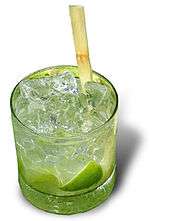 |
Brazil's national cocktail made with cachaça (pronounced: [kaˈʃasɐ]) (sugar cane hard liquor), sugar and lime.[12] Cachaça is Brazil's most common distilled alcoholic beverage (also known as Pinga or Caninha). Both rum and cachaça are made from sugarcane-derived products. Specifically with cachaça, the alcohol results from the fermentation of sugarcane juice which is then distilled. |
See also
References
- ↑ "Way of Life". Encarta. MSN. Archived from the original on 2009-10-31. Retrieved 2008-06-08.
- ↑ IBGE. 2011 Population Projection
- ↑ "Geography of Brazil". Central Intelligence Agency. 2008. Retrieved 2008-06-03.
- 1 2 "Angu - Brazilian Polenta". About.com. Retrieved 2013-06-06.
- ↑ David Quammen, The Song of the Dodo: Island Biogeography in an Age of Extinctions (Simon & Schuster, 2011), p. 469.
- ↑ Tom Streissguth; Streissguth, Thomas (2003). Brazil in pictures. Minneapolis: Lerner Publications. p. 54. ISBN 0-8225-1959-3.
- ↑ (Spanish) Receitas
- ↑ Prince of the People: The Life and Times of a Brazilian Free Man of Colour - Eduardo da Silva - Google Books p. 66.
- ↑ Mocoto - Definition of Mocoto - Brazil Food
- ↑ (Spanish) Receita de Mocotó
- ↑ Eating the Amazon: 18 Intriguing Brazilian Foods: Food + Cooking : gourmet.com
- ↑ "Decreto Nº 4.851, De 2 Outubro De 2003" (in Spanish). Legis.senado.gov.br. Retrieved 2013-06-06.
South American food is mostly Spanish
This article is issued from Wikipedia - version of the 11/22/2016. The text is available under the Creative Commons Attribution/Share Alike but additional terms may apply for the media files.